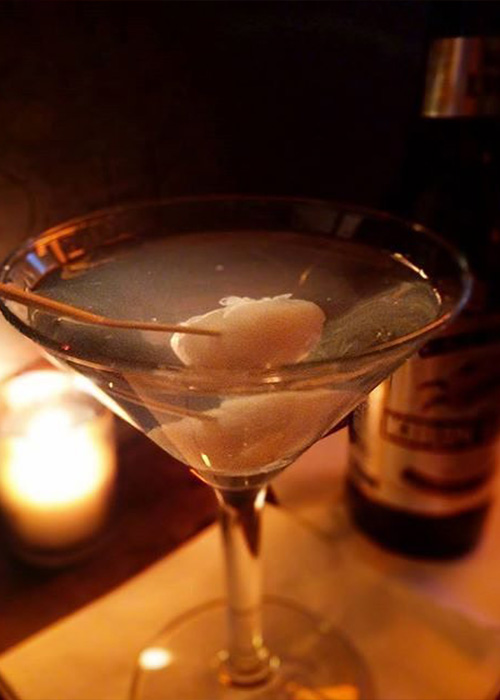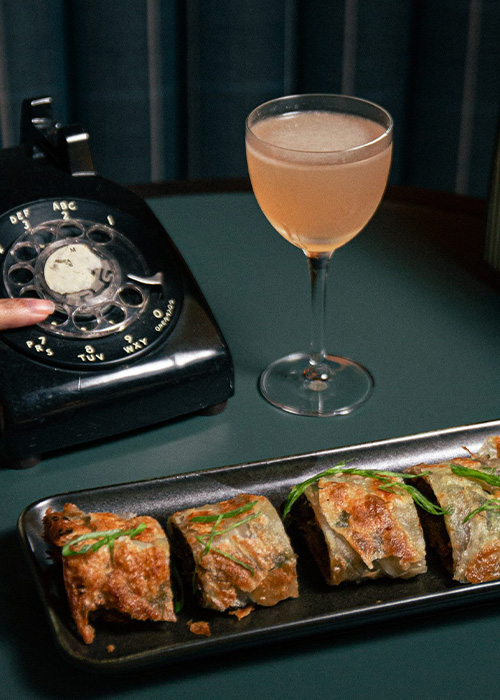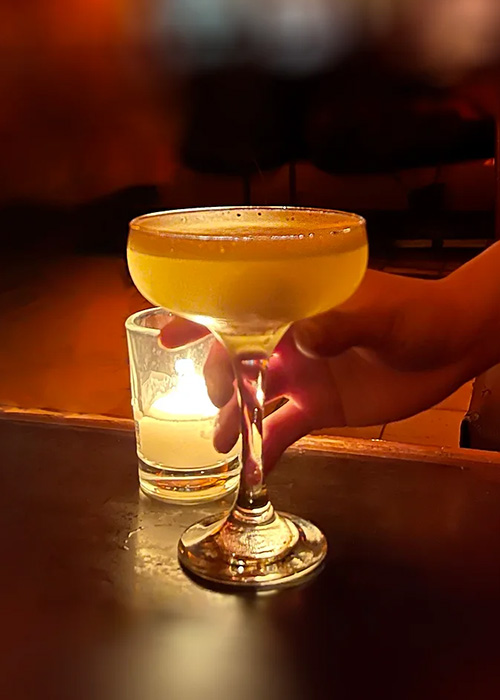The Lychee Martini has come a long way since it first took New York City by storm in the ‘90s. In recent years, what was once a pink symbol of sugary indulgence crafted more for its aesthetic appeal than its flavor has undergone somewhat of a transformation. Today, a new generation of bartenders is reclaiming and redefining the Lychee Martini — breathing new life into the drink by balancing its sweetness, incorporating fresh ingredients, and honoring the Asian cultural heritage behind its namesake ingredient.
This evolution isn’t just about tweaking a recipe, either. From its beginnings as a playful, sweet drink embraced by the nightlife scene in early aughts New York (TAO, anyone?) to its present-day reinvention as a sophisticated yet utterly gulpable cocktail, the Lychee Martini is on to a new, exciting chapter.
A ‘90s Kid in NYC
The Lychee Martini made its debut in the early 1990s, a decade marked by the rise of fruity, saccharine cocktails like the Cosmopolitan and Appletini. There are multiple theories on where the Lychee Martini originated, but most claim it was first created at Sake Bar Decibel, a Japanese sake bar in the East Village opened in 1993 by Bon Yagi. The drink had allegedly already proven popular at his brother’s bar in Tokyo, and Yagi introduced it to Decibel at the perfect time — the height of Martini madness.
Typically made with vodka, canned lychee fruit, and lychee syrup, the original version was intensely sweet, which both contributed to its popularity and, eventually, to its downfall. As with many popular builds from the ‘90s, like the Espresso Martini, its one-dimensional flavor began to feel blasé as trends shifted toward more balanced and complex creations and Prohibition-era classics in the early aughts.
The Lychee Martini’s introduction to Western audiences also played into the broader trend of fusion cuisine during the 1990s, which saw Asian ingredients and dishes often stripped of their cultural significance to appeal to a Western palate. The lychee and its deep roots in Asian history were no exception, with Asian-inspired restaurants and club-staurants shilling them out by the dozens every weekend.
A Fruit With Rich Symbolism
Native to southern China, lychee was prized there for over a thousand years before New Yorkers started mixing its juice with vodka. In Chinese culture, the fruit is often associated with luxury and royalty and was famously beloved by Emperor Xuanzong of the Tang Dynasty, who went to great lengths to make sure fresh lychee was delivered to his concubine. (Cue “Everything is romantic.”) Beyond China, lychee holds a special place in Southeast Asian cuisines, making regular appearances in desserts, beverages, and even savory dishes in countries including Thailand, Vietnam, and the Philippines.

Fresh lychee’s flavor profile — delicately sweet with floral and fruity undertones — makes it a versatile ingredient that’s historically been underappreciated and underutilized in its Western interpretations. Now, its nuance is finally beginning to gain recognition, thanks to bar directors who respect its legacy. The result is a quickly expanding plethora of nuanced riffs on the Lychee Martini, making appearances on New York City’s buzziest cocktail menus.
The Modern Reclamation
The Lychee Martini’s evolution reflects a broader movement in cocktail culture: the increasing use of Asian ingredients and techniques in modern mixology. Bartenders are experimenting with traditional Asian spirits like soju, baijiu, and sake stateside as well as incorporating exports such as pandan, lemongrass, and sesame, creating drinks that are both delicious and culturally resonant.
“Using Asian spirits and ingredients helps expand my creativity. There are so many wonderful ingredients with unique flavors that are finally front and center.”
Take the fruit-forward iteration of the Lychee Martini at NYC’s Nomad Tea Parlour, a newly opened Flatiron restaurant positioned as a celebration of Cantonese-American food. There, the Just a Lychee Martini features Empirical Soka (a Danish spirit created from the distillates of fermented fresh sorghum juice and syrup), Ming River Baijiu, lychee, strawberry, grapefruit, and white tea. Fruit liqueurs help to coax out the great aromatics and subtle fruity, strawberry notes of fresh lychee, while an infusion of white tea aids in drying out the cocktail, helping to maintain the right balance of fruity, floral, sweet, and tart.

“I am someone who tends to get tired of the same ingredients over and over again so using Asian spirits and ingredients helps expand my creativity,” says Nomad Tea Parlour’s beverage director, Gregory Kong. “There are so many wonderful ingredients with unique flavors that are finally front and center.”
“We opened right after Sept. 11 and the area was really dead. We needed to attract some business, so we put the Lychee Martini on our happy hour menu. Back then it was just $4, and I think that’s what launched it as a fan favorite.”
At the newly opened Theatre District location of beloved cocktail bar Dear Irving, you’ll find the Fleur de Lychee featuring honey, lychee-infused sake, and vodka. Madeline’s Martinis in Alphabet City is serving up a tequila-based Lychee Martini freshened up with lemon juice and saline, and underground at Midtown East’s Tomi Jazz, the frozen Lychee Martini is made with rum, Triple Sec, lychee syrup, and lime juice. And to accompany enormous bowls of slurpable udon, the Lychee Bouquet at Union Square’s TsuruTonTon is made with Haku Vodka, lychee puree, lychee sake, and pineapple juice.
If It Ain’t Broke
While these riffs show off the Lychee Martini’s potential depth, many prize the cocktail for its OG simplicity. Luckily, though, there are still plenty of spots that have been serving them the same way for decades, with no plans to deviate any time soon. Lychee Martinis are still available at Decibel, their place of creation. They’re also the most ordered drink at Verlaine, a longstanding Asian-inspired spot in the Lower East Side of Manhattan. There, owner Gary Weingarten says they pour up around 2,500 Lychee Martinis per week.

“We opened Oct. 26, 2001, we made the Lychee Martini the second week we were open, and it’s been the same ever since,” says Weingarten. “We opened right after Sept. 11 and the area was really dead. We needed to attract some business, so we put the Lychee Martini on our happy hour menu. Back then it was just $4, and I think that’s what launched it as a fan favorite.”
“It’s been great to see how knowledgeable and comfortable people have become with some of the more unique or unknown ingredients and flavors.”
When Weingarten added the cocktail to his menu, he hadn’t even tasted a Lychee Martini before. Instead, he had ventured to patronize the neighboring markets in Manhattan’s Chinatown in an attempt to better understand the produce he had to work with for his Asian-inspired concept. What he found were then-unfamiliar fruits: lychee, longan, rambutan, loquat. Bringing the bounty back to the bar, he began to experiment, and Verlaine’s now-iconic Lychee Martini, sweetened and balanced with pineapple juice, was born. At the time of the establishment’s inception, Weingarten recalls it being a watering hole that the AAPI community flocked to, citing their enthusiasm for the cocktail as “what really helped it take off.”
One could argue it’s that same enthusiasm for exciting, new takes on beloved flavors that drives AAPI bartenders today to continue riffing on now-classics, like the Lychee Martini.
“I am Korean, and have worked in Korean-, Japanese-, and Chinese-inspired restaurants and bars, so a lot of these used to be things we would have to explain to guests,” says Kong. “It’s been great to see how knowledgeable and comfortable people have become with some of the more unique or unknown ingredients and flavors.”
